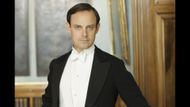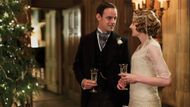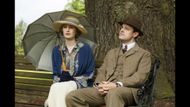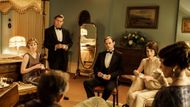Downton Abbey is remembered for its polish. Period costumes, heavy wooden furniture, and the formality of the Crawley home. The impression was that every object and every line had been checked again and again. Yet a very simple thing slipped through. Actor Harry Hadden-Paton, who joined the series as Bertie Pelham, said he did not actually know his character’s real first name until filming the last episode. For months, he thought it was only Bertie. Sometimes he even imagined it might be Albert. The actual name was Herbert. The moment of discovery was unusual: it came during the wedding of Bertie and Lady Edith.
What stands out is not the oversight itself, but the contrast with the reputation of Downton Abbey. A production known for strict accuracy still allowed for this kind of surprise. It turned into a story often repeated when the cast looked back at the show.

From introduction to finale
Hadden-Paton first appeared in the 2014 Christmas special. His character entered quietly, without the weight of titles that other figures carried. Over time, Bertie’s importance grew. By the end of the series, he had become the 7th Marquess of Hexham. His partnership with Lady Edith developed into a central plot point, one that shaped the closing chapters. The marriage between them was not only a personal turning point for Edith but also a symbolic gesture that balanced years of difficulties written for her character.
It was in this setting, the most decisive moment for Edith, that Hadden-Paton finally saw his character’s full name printed in front of him.
The wedding program
At the premiere of Downton Abbey: The Grand Finale, Hadden-Paton shared the story in an interview with People. He recalled keeping the wedding program from the scene. That simple sheet of paper revealed the detail that had been missing for so long. The cover listed The marriage of Herbert and Edith. It was the first time he realized that Bertie Pelham was actually Herbert Pelham. Until then, he admitted he had assumed otherwise.
The program became more than just a prop. It turned into proof of how even an actor involved in a central storyline can discover new information at the very last stage.

A scene that defined the ending
The wedding itself was central to the series finale. Edith, often described as the overlooked sister, received the ending that audiences had long hoped she would. The marriage sealed her role in the family and in society. For viewers, it was a conclusion that tied together many years of watching her struggles and setbacks. For Hadden-Paton, the same moment carried an additional revelation, one unrelated to plot but impossible to forget.
The combination of a happy ending on screen and a personal surprise behind the scenes added another layer to how that episode is remembered.
Objects and memories from Downton Abbey
Beyond the discovery of the name, Hadden-Paton mentioned another detail. At the end of filming, he kept a three-piece suit from the production. Later, when work began on the 2019 feature film, he was asked to return it. The program from the wedding, however, stayed with him. That single item became the piece he still holds from Downton Abbey.
Small stories like these underline how a production lives on in memory. Costumes, props, scripts, and even mistakes all contribute to how the cast and the audience recall the project years later.

Reception and recognition
Downton Abbey started in 2010, and right away, people noticed it. The series caught attention, critics talked, and soon the big awards came too. Golden Globes and Emmys, all adding weight to something that was already finding an audience far beyond the UK. It ended up on screens everywhere, turning into one of those British dramas that almost everyone had heard about. What people said most often was how well it showed the changes of the time. Life upstairs with the Crawleys and, at the same time, the work and routine of those living downstairs. Two worlds in the same house, always crossing.
The marriage of Edith and Bertie, later Herbert, became a symbol of closure. It concluded long-running tensions, giving Edith the position she had been denied for so many years. The additional revelation from Hadden-Paton did not alter the writing, but it offered a lighter note to add to the larger picture.
Films and continuation
The show ended on TV back in 2015, but that didn’t really close the door. A few years later, it popped up again, only this time in theaters. First came a film in 2019. Then another one in 2022. And by 2025, there was Downton Abbey: The Grand Finale, meant as the last chapter. Each time, people went back to that world. The Crawley family, the familiar rooms, and the circle of characters that kept pulling the story forward. It stretched longer than anyone thought at first, like the series just refused to stop right where it was supposed to.
Within this continuation, stories from the actors gained more value. Behind-the-scenes anecdotes became part of how the franchise is remembered. The case of Herbert Pelham’s name joined this group, not as a mistake but as a curiosity that humanized the entire process.

Closing thoughts
The truth about Herbert Pelham’s name did not change the outcome of the drama. It did not alter Edith’s arc or shift the direction of the finale. What it did was highlight how even a series celebrated for precision could carry hidden surprises. For audiences, it became an amusing fact. For the actor, it stayed tied to a program of a wedding scene, still preserved today.
Downton Abbey remains an influential title in recent British television history. Its legacy comes from complex characters, visual detail, and memorable performances. Yet it also endures through moments like this one, where the smallest discovery continues to echo years after the last episode aired.
